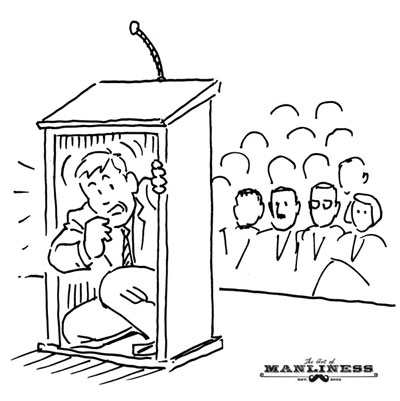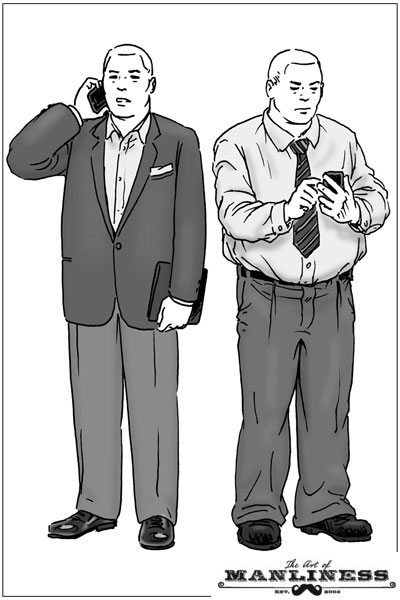3 Strategies To Look Your Best, Men
Are you intentionally making mistakes at work to make yourself look incompetent?
Are you purposely sabotaging your presentations?
Are you setting yourself up for failure as an instructor?
Hopefully, the answer is no.

Yet the vast majority of men I see who want to be influential fail to master the three tips I’ll share today. But I’m getting ahead of myself.
Men spend a lot of time, money, and effort learning to be more persuasive speakers and negotiators. And for good reason — mastering these skills can reap huge returns when it comes to business and personal success.
But what if there were something you could do that would dramatically increase your persuasiveness without any extra effort or training on your part?
Would you take advantage of it?
If the answer is yes, it’s time to start thinking more about your personal appearance and how it relates to the art of persuasion and influence.
Attractiveness and Persuasion
We like to think that persuasion is a matter of good arguments and compelling rhetoric — in part because we don’t want to believe that we can be swayed by anything less.
The research says otherwise.
There have been a number of studies in the last fifty years that demonstrate people’s tendency to be more persuaded by attractive speakers than by unattractive ones.
In 1979, Shelly Chaiken published a paper on her study of instructors in academic settings. She found that instructors rated as “attractive” by their students could generate significantly higher levels of agreement from their audience than ones rated as “unattractive.” Even more impressively, the study also demonstrated that students actually performed better when they had an instructor they found attractive.
Why Attractiveness Affects Influence
It’s a little disheartening to think that just being handsome can make people under your leadership perform better, or make audiences more likely to agree with your point of view.
Worth bearing in mind is that it’s not a one-way street. Attractive individuals tend, on the whole, to have an easier time in social situations than unattractive ones. That, in turn, encourages them to be more outgoing and social, which gives them more practice with their interactive skills.
But with that said, there’s also an effect on the viewer’s brain when a person is particularly attractive. Our brains are big into shortcuts. Give them a chance and they’ll save mental energy by categorizing people into simple, all-or-nothing terms like “good” and “bad,” or in this case, “attractive” and “unattractive.”
That gives us a tendency to take a broad, generalized assumption about a person, such as “he looks good,” and then ascribe that quality to specific judgments as well, such as “he’s probably a good teacher,” or “he must be a good father.”
This is called the “halo effect.” It was first studied in the 1920s by a researcher named Edward Thorndike, who had noticed that in military evaluations, officers who were ranked highly in some qualities were ranked highly in other, unrelated categories as well. Similarly, officers with low rankings in some categories usually had low rankings in others.

What does a squared-away uniform say about a Marine?
Objectively, the results didn’t make sense. Unrelated qualities like physical fitness and mental attentiveness should, in theory, be randomly distributed. You might get one or two high performers very good at everything they do, and one or two washouts who aren’t good at anything, but in general people should be good at some things and not at others.
What Thorndike found, however, was that one strong positive impression — an officer’s physique, say, or his attention to neatness and punctuality — was enough to generate an overall “good feeling” that spilled over into the rest of the evaluation. Once the person filling out the evaluation noticed something good about an individual, he assumed that they were good at other things too. The result was true for negative impressions as well.
Studies have shown, with remarkable consistency, that the halo effect is real and has a statistically significant effect on people’s success, in everything ranging from education to politics to courtroom defenses (one study showed that attractive people received much more lenient sentences than unattractive ones, even when convicted of the exact same crime).
This effect comes into play when you’re trying to persuade, in any setting or situation. The more positive people’s first visual impression of you is, the more positive traits they’ll associate with everything you say. A 1975 study found that clothing had more impact on first impressions in social settings than the person wearing the clothing — powerful stuff when you’re getting up in front of an audience!
How to Dress to Persuade
It should be obvious, then, that anyone who needs to persuade — for a job, a cause, or anything else — wants to look as “good” as possible.
But what is “good,” in personal appearance?
1. Be Free of Imperfections

Can you spot the imperfections that different clothing exaggerates or masks on the same man?
To persuade, be meticulous.
Be meticulous about your hair, be meticulous about your shoes, be meticulous about your clothes. Everything counts.
Your goal when you prepare for a persuasive speech or sales pitch is to eliminate imperfections.
A tuft of hair out of place or a scuff on your shoes may not seem like much, and realistically, most people won’t consciously notice something minor like that, but their subconscious mind is still picking up the visual signal of asymmetry, and that tells the back of their brain that something isn’t quite right. The result is a vague, indefinable and off-putting sensation that the viewer won’t even be aware of — but that will be coloring his or her judgment of you.
Our brains evolved to use basic bilateral symmetry as a sign of good health and development, so they easily pick up on anything that deviates from that pattern. Always strive for a symmetrical look — or, when you break it, for a firm and deliberate asymmetry. A bright splash of color on one breast from a pocket square is fine; a faint stain on one lapel is not.
Remember that humans can generally only pay attention to one thing at a time. Our brains and our eyes are good at focusing, but bad at interpreting multiple stimuli at once. If you give people something out of place to focus on, they’re going to zero in on it. Thinking about how your tie doesn’t go well with your pants takes up the brain space they should be using to consider your message.
When you think about it, even things that we recognize as major gaffes aren’t much more than small details done wrong. Showing up at a presentation with your fly unzipped is, in practical terms, a flaw in maybe 1-2% of your total appearance. The rest of your outfit looks just fine! But we all know how big of a difference that one little zipper out of place is — it’s a deal breaker, guaranteed.
Things that logically have nothing to do with your intelligence or with the value of the message can still leave people thinking that you’re unconvincing. So take the time you need to get everything just right.
Aim for perfection. Go for the extra slow shave, the just-right-for-you hair product, the shoeshine in the airport. They end up mattering.
The post 3 Strategies To Look Your Best, Men appeared first on LewRockwell.
Leave a Reply